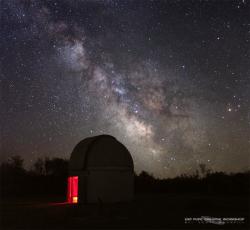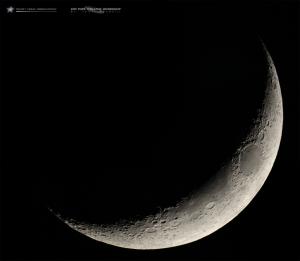
Public Stargazing
- Where:
- Frosty Drew Observatory
- When:
- Friday May 30, 2014 at 6:00 p.m.
- Cost:
- $1 Suggested Donation per Person
Tonight's forecast is calling for partly to mostly cloudy skies after 7:00 p.m. with a chance of t-storms and showers. The beautiful, super thin 6% waxing crescent Moon will set at 9:40 p.m. offering us super dark skies. Since the forecast is calling for only partial cloud cover, we will stay on standby and monitor the skies for viewing opportunities. Follow @FrostyDrewOBSY on Twitter for status updates from the observatory. This will aide in making an informed decision on whether to trek out. We plan to open at 6:00 p.m. and will have either live views of the Sun in the Sky Theatre and Observatory or a slide show and videos, depending on sky conditions. At 8:30 p.m. we will begin monitoring the night sky for clearings and open the telescopes if viewing is acceptable. If not for the clouds, tonight would have been an excellent night to be at Frosty Drew!
Tonight's target list will feature Mercury, Jupiter, the Moon, Mars, and Saturn. Globular clusters M5, M13, and M92 will be in view tonight as well as planetary nebulae M57 (The Ring), and M27 (The Dumbbell). These are just a few of the objects we will be observing tonight if the weather permits.
Visitors traveling long distances should probably stay home tonight as the likelihood for cloudy skies is high. Let's hope for a clearing tonight and an overall break in this terrible trend of cloudy, rainy, and dismal Fridays we have been in since the start of Spring, our best viewing season.
-------------------------------------------------------------------------
Weekly Happenings
Scott MacNeill
On May 9, 2014 a large Coronal Mass Ejection (CME) blasted off the side of the Sun and NASA's newest solar observatory, for the first time, captured the event in super high detail. The Interface Region Imaging Spectrograph (IRIS) is NASA latest solar observatory. Launched in June 2013, just one year ago, IRIS is tasked with studying how solar energy heats up and travels through the solar chromosphere. The IRIS telescope has 8” of aperture and is able to view, in high detail, regions of the Sun as small as 150 miles in diameter. Well on May 9th, IRIS was focused on an active solar region situated on the side of the Sun when a huge CME erupted from the region. IRIS captured the CME as it occurred, showcasing massive amounts of solar material exploding into space at speeds of 1.5 million miles per hour through a field the size of five Earth diameters. The extraordinary capture is the first ever CME to be viewed at this resolution by the IRIS spacecraft. Check out the awesome CME explosion captured by IRIS:
Go IRIS!
The Moon, our celestial partner, is a perfect example of an amazing object that we totally take for granted. But no matter how often we see it, the view never becomes dull. Sky watchers will frequently complain about how the bright Moon illuminates the atmosphere making it difficult to observe the Milky Way and many dim objects like star clusters, nebulae, and galaxies. Though this complaint only applies to a small period of the complete lunar cycle. The rest of the time, the Moon really is a stunningly remarkable object to view. Well this weekend and early next week will be an excellent example, loaded with excellent lunar viewing opportunities.
Step outside after sunset these next few nights to catch a fantastic view of the thin crescent Moon. Each night the crescent will increase by 5% - 10% (called “waxing”), eventually reaching first quarter on Thursday, June 5th. When the Moon is in a thin crescent phase, an excellent phenomenon called Earthshine becomes visible. Earthshine happens when sunlight reflecting off of Earth illuminates the shadow side of the Moon. The glow produced by Earthshine will give the Moon a ghastly appearance as it hangs low in the Western sky. Additionally, the thin crescent will not significantly illuminate the sky, allowing background stars to shine brightly. Binoculars or a small telescope will offer breath taking views of the crescent phase and with warmer temperatures dominating the Spring nightscape, comfortable viewing avails. If anybody snaps a photo of the slender crescent Moon, post it on our <a href="http://www.facebook.com/FrostyDrewObservatory" title="Facebook" target="new">Facebook</a> and we will share it on our time-line.
-Scott

